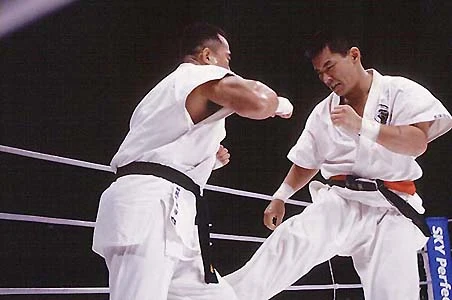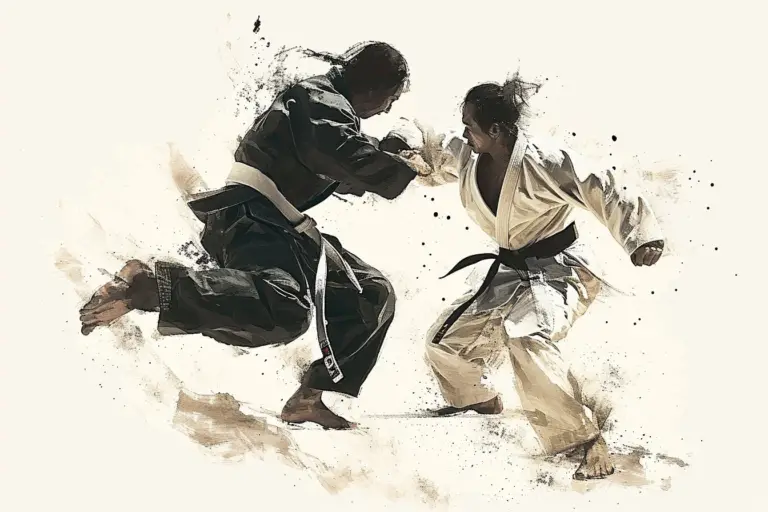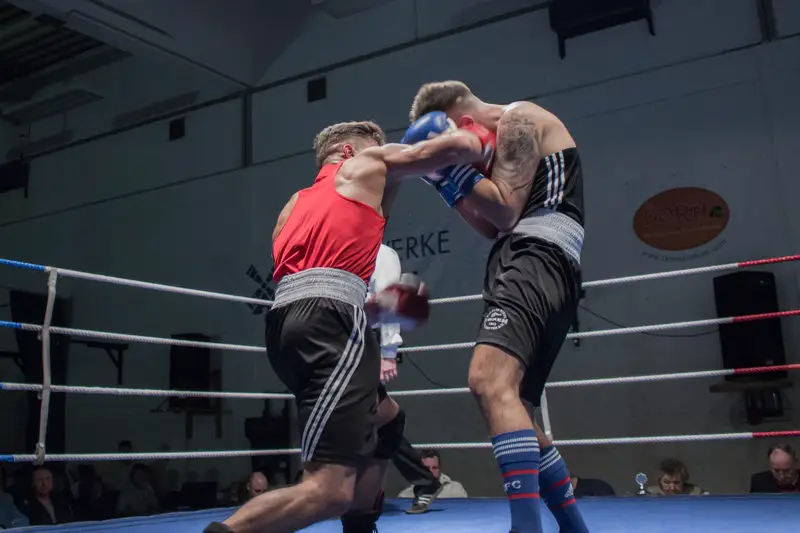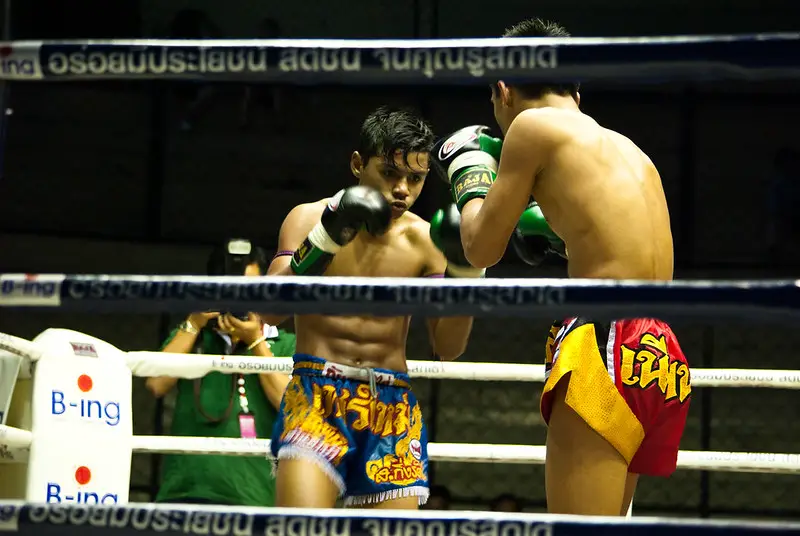Are you wondering if Kyokushin karate is effective for self-defense?
In this article, you will discover why Kyokushin is one of the best self-defense martial arts, and more about its realistic training approach, techniques, lack of protecting gear that adds to the realism of street fighting, and much other unique information.
Is Kyokushin Karate Effective In A Street Fight?
Kyokushin is the most effective karate style for self-defense and one of the best of them all. Its realistic approach to training, hard techniques, and gruelling conditioning workouts will prepare you for the type of combat you may face in street fighting.
The majority of other karate styles focus on light contact and competition. Students no longer spar hard, nor do they train how to do damage in a fight and defend. The learning program is oriented toward competition, winning points with strikes and matches. But Kyokushin is different.

Though competition is important, Kyokushin is far more realistic because it embraces full contact and hard sparring. These two methods are most important in terms of self-defense training, and preparing a person for mental and physical challenges that they face in real combat.
Training in Kyokushin, students learn how to fight using proper striking techniques at all ranges. They also train their, instincts, minds, and body to endure huge damage and punishment, stay calm, and respond effectively.
What Makes Kyokushin Karate Effective For Self-Defense?
First, Kyokushin teaches proper fighting techniques in a realistic way that is in line with the type of fighting you face in real life fighting scenarios. The lack of gear such as padded gloves also plays a big factor in self-defense training and adds to the realism of the system.
Let’s take a closer look into all of the factors that make Kyokushin good for real fighting.
Realistic training
The learning program puts a lot of emphasis on hard sparring. On a daily basis, students engage in these sessions where they practice how to apply techniques against their partner. This way they build instincts and muscle memory, improve form, and prepare for real combat.
In contrast to other karate styles, Kyokushin allows full contact which is important for self-defense where there is no light contact or rules.
Also, training places a strong emphasis on physical conditioning, including strength, endurance, and flexibility. This ensures that practitioners are physically and mentally prepared for the unpredictable and intense world of real life fighting.
Teaches you how to fight without the gear
Speaking of realism, Kyokushin doesn’t include fancy gear you can find in other arts like boxing for instance. Students spar without wearing padded gloves, shin pads, or head guards. They only wear hand wraps and mouth guards to protect their teeth and jaw. That’s it.
Though this may seem brutal, it adds to the realism as there is no gear in street fighting. Most boxers or MMA fighters tend to break their hands as they are not used to striking without protection. But Kyokushin teaches you how to control the power and always hit at the right angle to avoid injuries.
This single factor makes Kyokushin effective for self-defense, even more than most other combat systems.
Proper Fighting Techniques
Apart from realistic teaching methods, students also learn legitimate combat techniques. The emphasis is on versatile kicking techniques and direct striking with your hands. There are also different types of blocks and defensive maneuvers all designed to be practical.
The focus is on the strikes that do not require much time and energy to execute. But at the same time, these strikes can generate big power, and do a lot of damage upon impact. This makes Kyokushin energy efficient in real fighting, which is important.
Kyokushin also includes throws and sweeps in its repertoire, allowing practitioners to off-balance and control opponents. Executing a throw can buy you time to run away, or establish a dominant position over the attacker.
Power and Damage
These two aspects are important for self-defense training. The nature of real street fighting is violent and unpredictable. You want to have the skills and abilities to land quick and powerful blows to finish the fight as fast as possible. There are no rules on the streets when your life is in danger, you need to be efficient.
Kyokushin training emphasizes striking with full power and doing damage. Practitioners develop strong punches, kicks, and knee strikes, which can be effective in neutralizing an attacker. They train to land each of these shots with the goal to cause injuries and finish the fight.
Best Kyokushin Self-Defense Techniques
Kyokushin Karate, known for its rigorous training and full-contact sparring, offers several effective techniques for self-defense. Here are some of the most effective ones:
- Mae Geri (Front Kick) – is a powerful front kick delivered with the ball of the foot. It can be used to keep an attacker at bay or strike directly to the groin, solar plexus, or face.
- Oi-Zuki (Lunge Punch) – is a straight punch delivered with the lead hand while stepping forward. It’s effective for quickly closing the distance and striking the opponent’s midsection or face.
- Gyaku-Zuki (Reverse Punch) – is similar to the lunge punch, but delivered with the rear hand. It’s a strong technique for close-range combat, aiming at the opponent’s vital areas.
- Mawashi Geri (Roundhouse Kick) – is a powerful rotational kick targeting the head, ribs, or legs. It can be delivered with either the instep or the shin, depending on the situation.
- Ashi Barai (Foot Sweep) – is a low sweeping technique used to destabilize an opponent’s balance and bring them to the ground, creating an opportunity for further action.
Remember, the effectiveness of these techniques depends not only on their execution but also on factors such as timing, distance, and situational awareness.
Is Kyokushin Karate Dangerous To Train In?
Kyokushin is a full-contact martial art, and as such, it carries a risk of minor or severe injuries. Further, it is a hard striking style that emphasizes sparring so the injuries are more common than in other sports.
However, the danger of training is based on different factors. This includes the individual’s health, the quality of instruction, and the training environment. What makes Kyokushing Dangerous more than other arts are the following factors:
- Physical demands — Kyokushin is known for its rigorous training. There is a lot of intense conditioning, full-contact sparring, and powerful striking techniques. This can lead to physical stress on the body, and injuries such as bruises, strains, and sprains.
- No protective gear — increases the risks. Since there are no gloves, shin pads, or head guards, students get hurt more often than in other arts. But this practice is changing and more schools are adopting the gear.
- Intensity — is one of the biggest contributors to the high injury rate. There is an emphasis on throwing strikes with full power, which combined with the lack of gear makes Kyokushin training dangerous.
The safety of training largely depends on the quality of instruction. A knowledgeable and experienced instructor who emphasizes proper technique, gradual progression, and safety measures can significantly reduce the risk of injuries.
Also, many schools have started changing their stance on safety and have started adopting protective gear as mandatory.
Is Kyokushin The Hardest Karate Style?
Kyokushin is widely regarded as the strongest karate style when it comes to modern practice. This is due to its heavy emphasis on full contact, realistic training, sparring, and the absence of protective gear. Characteristics that many practitioners find effective for self-defense.
In general, traditional karate, developed in Okinawa, is considered the strongest due to its self-defense emphasis. Though hard, Kyokushin also focuses heavily on competition, which is why there are no punches to the head for instance, which also makes it quite limited compared to the versatility of traditional practice.
However, bear in mind that all karate styles have pros and cons. The effectiveness of a martial art often depends on the individual practitioner’s skill level, training, and adaptability. Some other well-known styles of karate include Shotokan, Goju-Ryu, and Wado-Ryu.
In summary, Kyokushin is recognized for its emphasis on practicality and physical conditioning, but whether it is considered the “strongest” karate is subjective and varies among martial artists and practitioners
Is Kyokushin Karate Used in MMA?
Yes, elements of Kyokushin Karate are often used in MMA. There have been many MMA fighters with a strong background in this karate style. This includes the likes of:
- Bas Rutten — 5th degree black belt
- George St. Pierre — 3rd dan black belt
- Guy Mezger — 6th dan black belt
Still, Kyokushin conceptually does not fit well within the MMA rules. There are similar options that work better such as Muay Thai, western kickboxing, or Boxing. But the mix of realistic training, kicks, and knees makes Kyokushin a solid base for anyone looking to transition to MMA.
While Kyokushin itself doesn’t traditionally include ground fighting or grappling techniques, its emphasis on powerful strikes, conditioning, and stand-up fighting can be valuable in the striking aspect of MMA.
However, it’s important to note that successful MMA fighters often integrate techniques and strategies from various martial arts disciplines to create a well-rounded skill set.
This might involve incorporating grappling from Brazilian Jiu-Jitsu, wrestling, or other striking styles to complement their Kyokushin foundation.
Final Thoughts – Can You Use Kyokushin Karate In a Real Fight?
Yes, Kyokushin karate training prepares you for most physical and mental aspects of real combat and self-defense. Though not THE best, this form of karate is perhaps the most effective of them all as far as modern practice is concerned.
The majority of other styles emphasize light contact and competition. Students no longer learn how to defend using full power as their main objective is to learn how to compete under strict rules using light contact. And this gives Kyokushin, which still sticks to its full-contact philosophy, an advantage.
However, bear in mind that training is hard on your body, and the injuries are inevitable. Do not join the classes thinking you won’t get hurt.
Is Karate Hard to Learn? (Expert Opinion)


